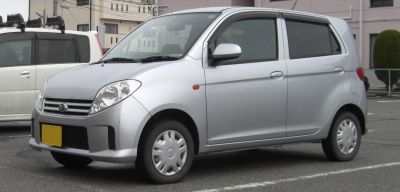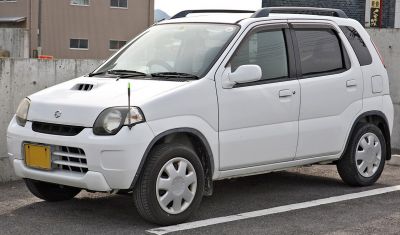 1999 Mazda Laputa Dimensions, Size & Specs
1999 Mazda Laputa Dimensions, Size & Specs
Measurements of the 1999 Mazda Laputa, engineered for optimal performance and comfort
| Dimensions | |
|---|---|
| Length: | 3355-3395 mm132.1-133.7 in11.0-11.1 ft |
| Width: | 1475 mm58.1 in4.8 ft |
| Height: | 1530-1550 mm60.2-61.0 in5.0-5.1 ft |
| Weight Specifications | |
| Curb Weight: | 750-810 kg1653-1786 lbs |
| Maximal permitted Weight: | 970-1030 kg2138-2271 lbs |
| Tire Specifications | |
| Rims Sizes: | Other Rims:
|
| Tire Sizes: |
|
The Mazda Laputa, produced between 1998 and 2006, is a compact hatchback designed for urban mobility and ease of parking. The first and only generation of the Laputa, available around the model year 1999, features a notably small footprint ideal for city driving. Its length ranges from 3355 mm to 3395 mm (132.1 to 133.7 inches), making it a highly maneuverable vehicle in tight spaces. The width of the car is 1475 mm (58.1 inches), contributing to its narrow profile which enhances navigation through congested streets and narrow lanes. Height varies between 1530 mm and 1550 mm (60.2 to 61.0 inches), providing a tall cabin relative to its compact length and width, which allows for a roomier interior compared to other cars in the same segment. The Mazda Laputa's curb weight lies between 750 kg and 810 kg (1653 to 1786 lbs), underscoring its lightweight construction that benefits fuel efficiency and handling agility. Maximum weight capacity varies from 970 kg to 1030 kg (2140 to 2270 lbs), offering adequate load-carrying capability for typical daily use. The vehicle is equipped with 14- and 15-inch rims sized 4.5J x 14 ET 50 and 4.5J x 15 ET 50, fitted with tires sized 165/70 R14 81S and 165/60 R15 77H respectively, balancing between ride comfort and road grip. Overall, the Mazda Laputa is a practical, space-efficient hatchback that blends compact exterior dimensions with a surprisingly spacious interior, tailored for drivers who prioritize convenience, efficiency, and ease of parking in urban environments.
Discover the standout features that make the 1999 Mazda Laputa a leader in its class
Have a question? Please check our knowledgebase first.
The Mazda Laputa produced from 1998 to 2006 features a compact hatchback body. Its length ranges from 3355 to 3395 millimeters (132.1 to 133.7 inches), providing a petite footprint ideal for urban driving. The width is consistently 1475 millimeters (58.1 inches), allowing for maneuverability in tight spaces without sacrificing stability. The height varies between 1530 and 1550 millimeters (60.2 to 61.0 inches), giving it a slightly tall profile typical of kei cars, which enhances interior headroom and ease of entry and exit.
The curb weight of the Mazda Laputa falls between 750 and 810 kilograms (1653 to 1785 pounds), making it a lightweight vehicle that benefits fuel efficiency and handling. Its maximum weight capacity, which includes passengers and cargo, ranges from 970 to 1030 kilograms (2138 to 2271 pounds). This weight balance makes the Laputa suitable for daily commuting and light cargo carrying, typical for a small hatchback in the kei car category.
Yes, the Mazda Laputa is well-suited for standard garage spaces. Most typical residential garages in many countries are around 2400 to 3000 millimeters (94.5 to 118 inches) wide and about 4800 to 6000 millimeters (189 to 236 inches) deep. With a width of only 1475 millimeters (58.1 inches) and length between 3355 to 3395 millimeters (132.1 to 133.7 inches), the Laputa fits comfortably within these dimensions, allowing room for opening doors and walking space around the vehicle.
The Mazda Laputa comes with two main rim sizes: 4.5J x 14 ET 50 and 4.5J x 15 ET 50. These rims correspond to two tire size options suitable for the different trims or configurations. The tire sizes are 165/70 R14 81S and 165/60 R15 77H. The 14-inch tires provide a balance of comfort and economy, while the 15-inch option typically enhances handling and a sportier feel while maintaining the small footprint necessary for urban environments.
The height of the Mazda Laputa ranges from 1530 to 1550 millimeters (60.2 to 61.0 inches), which is relatively tall for a car of its compact length and width. This increased height offers advantages such as improved headroom for passengers, making the cabin feel more spacious despite the compact exterior. The tall roofline also facilitates easier entry and exit, especially for elderly passengers or those with mobility challenges. Additionally, the elevated height can improve driver visibility, contributing to safer maneuvering in urban settings.
At a width of 1475 millimeters (58.1 inches), the Mazda Laputa is narrower than many standard vehicles, making it exceptionally maneuverable in congested city environments. This narrow width allows drivers to easily navigate tight streets, fit into narrower parking spots, and reduces the risk of door dings in crowded parking lots. It's a practical dimension for urban commuters who require a small, agile vehicle capable of handling limited space without compromising safety or comfort.
The Mazda Laputa is a unique model without a direct predecessor, as it was designed specifically to meet kei car regulations in Japan, combining functional compactness with a tall hatchback profile. However, compared to similar small kei car designs at the time, the Laputa distinguished itself with a taller stature and a focus on maximizing interior space within the confined external dimensions. Its design offered better headroom and a more versatile cabin space compared to many older kei cars, which often prioritized length and width over vertical space.
The Mazda Laputa competes in the kei car segment alongside models like the Suzuki Wagon R and the Daihatsu Move. Its height of up to 1550 millimeters (61 inches) is comparable or slightly taller than many competitors, contributing to a spacious cabin feel. While many kei cars focus on minimal footprint, the Laputa balances compactness (3355-3395 mm length, 1475 mm width) with practicality, providing good passenger comfort and cargo flexibility. Additionally, the Laputa's curb weight (750-810 kg) is typical for the class, supporting efficient fuel consumption and easy handling.
The hatchback design of the Mazda Laputa offers several practical benefits, including ease of access to the cargo area, allowing for flexible storage of larger items that wouldn't fit in a traditional sedan trunk. Its rear hatch facilitates convenient loading and unloading, especially useful in urban living situations where space is limited. The tall height coupled with the hatchback design ensures a spacious and versatile interior cabin, making the vehicle suitable for families and daily errands. Additionally, the hatchback styling contributes to a compact rear footprint, enhancing parking ease and maneuverability.
With a curb weight ranging from 750 to 810 kilograms (1653 to 1785 pounds), the Mazda Laputa is relatively light, which positively impacts fuel efficiency and vehicle agility. This low weight allows the engine to operate efficiently, minimizing fuel consumption essential for economy-focused urban driving. Moreover, the lighter weight contributes to nimble handling and easier braking, which is advantageous in stop-and-go traffic common in cities. The maximum weight capacity of 970 to 1030 kilograms (2138 to 2271 pounds) ensures the vehicle can comfortably carry passengers and cargo without compromising performance.
Discover similar sized cars.

| Production: | 2001-2003 |
|---|---|
| Model Year: | 2001 |
| Length: | 3395 mm133.7 in |
| Width: | 1475 mm58.1 in |
| Height: | 1550 mm61.0 in |

| Production: | 2002-2004 |
|---|---|
| Model Year: | 2000 |
| Length: | 3395 mm133.7 in |
| Width: | 1475 mm58.1 in |
| Height: | 1550 mm61.0 in |

| Production: | 2020-present |
|---|---|
| Model Year: | 2020 |
| Length: | 3395 mm133.7 in |
| Width: | 1475 mm58.1 in |
| Height: | 1545-1570 mm60.8-61.8 in |

| Production: | 1998-2009 |
|---|---|
| Model Year: | 1999 |
| Length: | 3395 mm133.7 in |
| Width: | 1475 mm58.1 in |
| Height: | 1530-1545 mm60.2-60.8 in |
